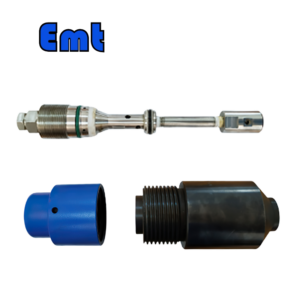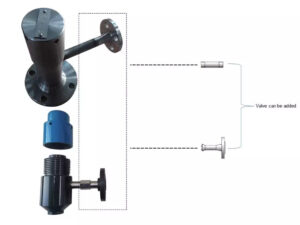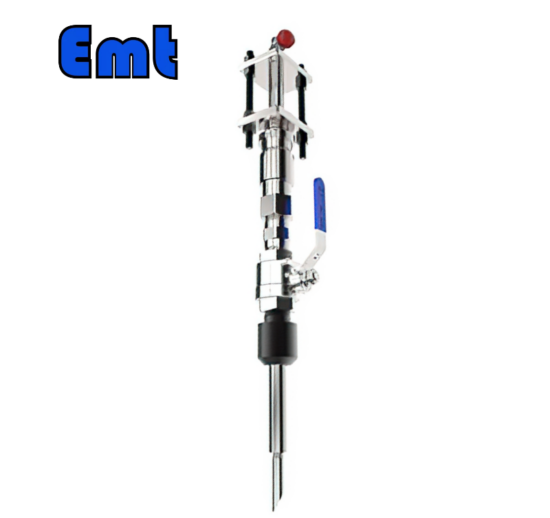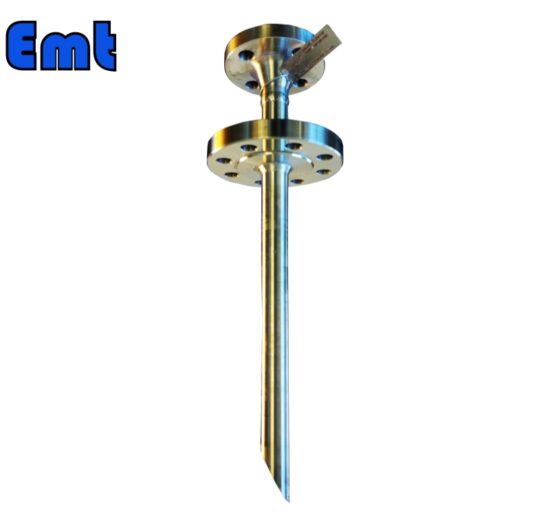Qu’est-ce qu’un Plume d’injection?
Une plume d’injection de produits chimiques est un dispositif spécialisé qui introduit des produits chimiques dans un pipeline de manière efficace et sûre. Il sert d’interface critique entre la ligne d’alimentation en produits chimiques et la canalisation, assurant une distribution contrôlée des produits chimiques. La conception de la piquante disperse les produits chimiques uniformément au centre du pipeline, les empêchant de s’accrocher aux parois du tuyau. Cette méthode permet d’éviter les dommages potentiels et d’assurer un mélange optimal. De plus, les piquants modernes comportent souvent des matériaux comme Kynar ou Hastelloy C-276 pour résister à la corrosion chimique. Les modèles avancés incluent des caractéristiques telles que des clapets anti-retour intégrés pour empêcher le refoulement lorsque les systèmes s’arrêtent, améliorant ainsi la sécurité et la fonctionnalité.
Différents types de buses
La société EMT propose une gamme variée de buses conçues pour répondre à divers besoins industriels. Chaque type de buse remplit des fonctions et des applications spécifiques, améliorant les performances et l’efficacité dans différents contextes. Voici une introduction détaillée aux quatre types de buses que nous proposons :
1. Buse parallèle
La buse parallèle est conçue pour les applications où le sens d’injection ou d’extraction doit être parallèle au flux du fluide dans le pipeline. Cet alignement est crucial pour les processus nécessitant un flux rationalisé afin de minimiser les perturbations et de maintenir la dynamique des fluides. Ces buses sont idéales pour les scénarios où une introduction en douceur de substances est nécessaire sans créer de turbulences ou de pertes de charge importantes.
2. Buse perpendiculaire
Notre buse perpendiculaire est conçue pour les cas où les substances doivent être injectées ou échantillonnées à angle droit par rapport au flux du pipeline. Ce type est particulièrement utile pour le mélange ou la dispersion complète d’additifs sur toute la section transversale de l’écoulement. Il est souvent utilisé dans les installations de traitement chimique et de traitement de l’eau où un contrôle précis du mélange et de la distribution des produits chimiques est nécessaire.
3. Ouvrez la buse
La buse ouverte présente une conception sans restriction qui permet une libre circulation des matériaux. Ce type est généralement utilisé dans les applications où il est nécessaire d’effectuer une introduction rapide ou une extraction sans résistance. Les buses ouvertes conviennent aux applications à haut volume et à basse pression et sont souvent privilégiées dans les systèmes de transfert en vrac et de gestion des déchets.
4. Buse d’échantillonnage
Spécialement conçue pour la collecte d’échantillons dans le pipeline, la buse d’échantillonnage garantit une contamination minimale et une intégrité précise des échantillons. Il est essentiel dans des industries telles que les produits pharmaceutiques, l’alimentation et les boissons, et les secteurs du contrôle de la qualité. La conception de ces buses facilite l’accès au contenu de la canalisation tout en maintenant les conditions de pression et de débit du système.
Chaque type de buse fourni par la société EMT est fabriqué avec précision, en utilisant des matériaux qui garantissent la durabilité et la compatibilité avec divers produits chimiques et conditions de fonctionnement. Qu’il s’agisse d’un mélange industriel, d’un échantillonnage ou d’un transfert de matériaux efficace, nos solutions de buses sont conçues pour offrir des performances et une fiabilité optimales.
Importance de Plume d’injection en tuyauterie
Les piquants d’injection jouent un rôle crucial dans les systèmes de tuyauterie, principalement dans l’introduction précise des produits chimiques. Ils évitent d’endommager les parois des tuyaux en assurant une distribution uniforme au sein du flux. Cette distribution est essentielle pour des réactions chimiques constantes et l’efficacité du processus. De plus, ils réduisent le risque de corrosion et prolongent la durée de vie de l’infrastructure pipelinière. De plus, leurs matériaux avancés comme Hastelloy et Kynar offrent une résistance contre les produits chimiques agressifs, améliorant ainsi la durabilité. En fin de compte, l’utilisation stratégique des piquants d’injection renforce à la fois la sécurité et l’efficacité opérationnelle dans les environnements industriels. Cela en fait des outils indispensables dans divers secteurs, notamment le pétrole, le gaz et les produits pharmaceutiques.
Le rôle des piquants d’injection dans l’industrie
Les piquants d’injection jouent un rôle central dans de nombreux secteurs en assurant une injection chimique précise et sûre dans les pipelines. Dans le domaine du traitement chimique, ces appareils permettent le dosage précis requis pour les réactions et les formulations de produits. Ils sont essentiels pour maintenir la qualité des produits et l’efficacité des processus. De même, dans les installations de traitement de l’eau, les piquants d’injection facilitent l’ajout contrôlé de produits chimiques de traitement. Cette précision permet de gérer efficacement les contaminants et d’assurer une production d’eau sûre.
De plus, l’industrie pétrolière et gazière s’appuie sur des piquants d’injection pour introduire des inhibiteurs qui empêchent la corrosion et le tartre dans les pipelines. Cela permet non seulement d’améliorer la longévité de l’infrastructure, mais aussi d’assurer un flux ininterrompu de pétrole et de gaz. Dans le secteur pharmaceutique, où la composition chimique exacte est essentielle, les piquants d’injection garantissent une distribution rigoureuse de volumes chimiques précis. Cette précision est cruciale pour maintenir l’efficacité et la sécurité des produits pharmaceutiques.
Les avantages de l’utilisation de piquants d’injection sont considérables. Tout d’abord, ils améliorent la sécurité en minimisant la manipulation directe des produits chimiques, réduisant ainsi les risques d’exposition. De plus, l’efficacité améliorée de la dispersion chimique garantit que les réactions se produisent uniformément, ce qui est essentiel pour la cohérence du produit. Enfin, en veillant à ce que les produits chimiques soient bien dispersés et non concentrés à certains endroits, les piquants d’injection réduisent l’usure et la corrosion des pipelines, prolongeant ainsi leur durée de vie opérationnelle et réduisant les coûts de maintenance.
Réponses d’experts aux questions courantes
Quels matériaux sont les meilleurs pour différentes expositions chimiques ?
Le choix du matériau d’une plume d’injection dépend du type de produits chimiques qu’elle manipulera. Pour les applications générales, l’acier inoxydable 316 est largement utilisé en raison de sa résistance à une large gamme de produits chimiques. Pour les produits chimiques plus agressifs, le Kynar (PVDF) convient pour sa haute résistance chimique, en particulier contre les chlorures et les acides. Hastelloy C-276 est excellent pour les environnements extrêmement corrosifs en raison de sa résistance exceptionnelle à la corrosion.
À quelle fréquence dois-je inspecter ma plume d’injection ?
La fréquence d’inspection d’une plume d’injection doit correspondre aux conditions opérationnelles et à la nature des produits chimiques utilisés. En règle générale, une inspection visuelle mensuelle est conseillée, tandis qu’une inspection plus détaillée devrait avoir lieu deux fois par an. Inspectez toujours plus fréquemment si la plume manipule des substances hautement corrosives ou fonctionne dans des conditions extrêmes.
Les piquants d’injection peuvent-ils être utilisés avec n’importe quel produit chimique ?
Bien que les piquants d’injection soient polyvalents, ils ne sont pas universels pour tous les produits chimiques. La compatibilité des matériaux est cruciale. Chaque matériau utilisé dans la construction de piquants offre des propriétés de résistance différentes. Consultez toujours les tableaux de compatibilité des matériaux ou un spécialiste lorsque vous choisissez une plume pour un nouveau type de produit chimique.
Quels sont les signes qu’une plume d’injection doit être remplacée ?
Les signes qu’une plume d’injection peut avoir besoin d’être remplacée comprennent des dommages visibles tels que des fissures, une corrosion importante ou une érosion sur le dard ou le corps. Des problèmes de performance tels qu’un dosage incohérent ou des fuites indiquent également qu’un remplacement peut être nécessaire. Des inspections régulières permettent d’identifier ces signes à un stade précoce.
Comment puis-je dépanner une plume d’injection défectueuse ?
Pour dépanner un piquant d’injection défectueux, commencez par vérifier qu’il n’y a pas de dommages physiques ou de blocages dans la plume ou le clapet anti-retour. Assurez-vous que la plume n’est pas obstruée par des débris ou des sédiments, ce qui peut entraver le fonctionnement. Vérifiez également que tous les raccords sont bien serrés et sécurisés pour éviter les fuites. Si les problèmes persistent après ces vérifications, consultez le fabricant ou un spécialiste pour un diagnostic plus approfondi.









Il n’y a pas encore d’avis.